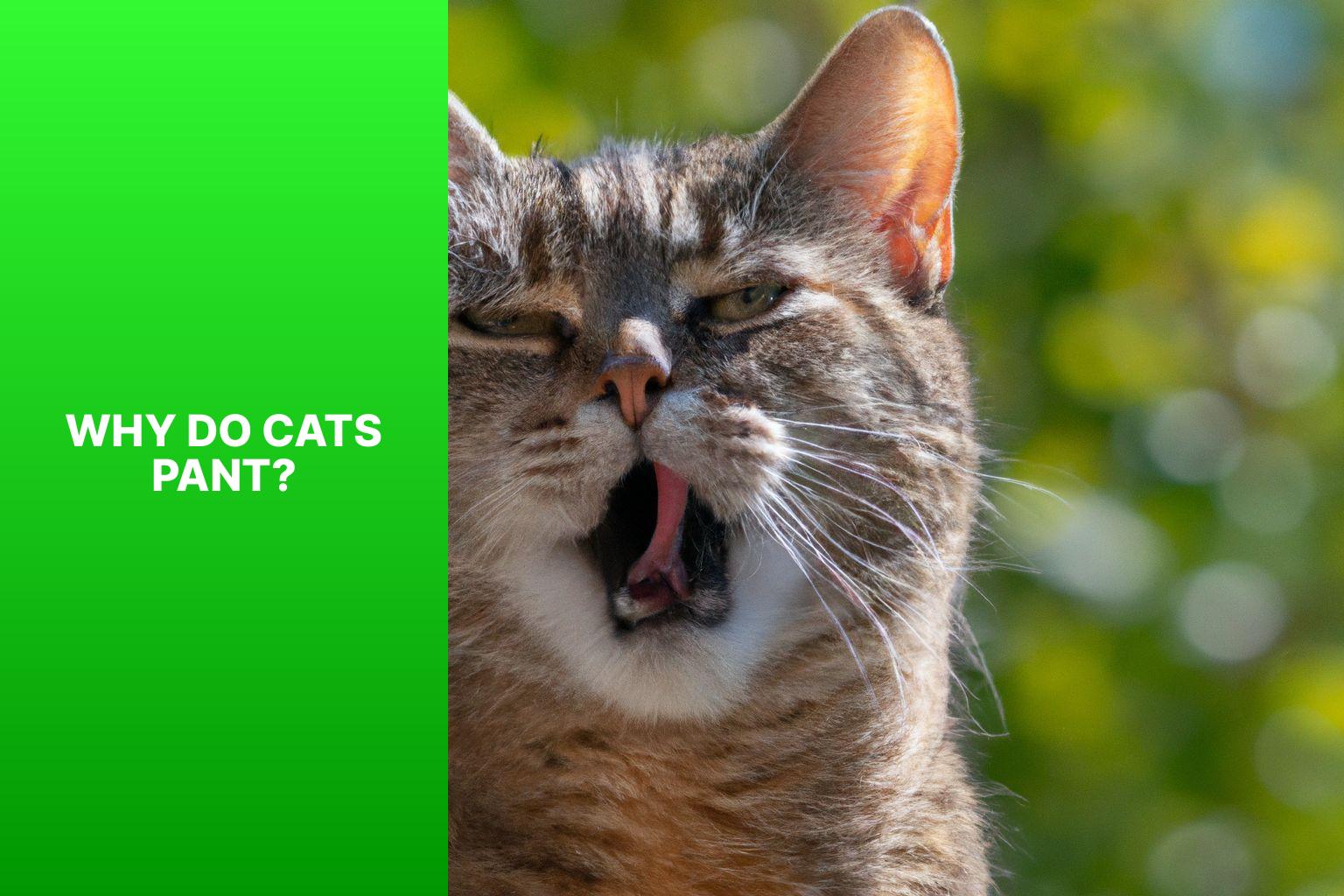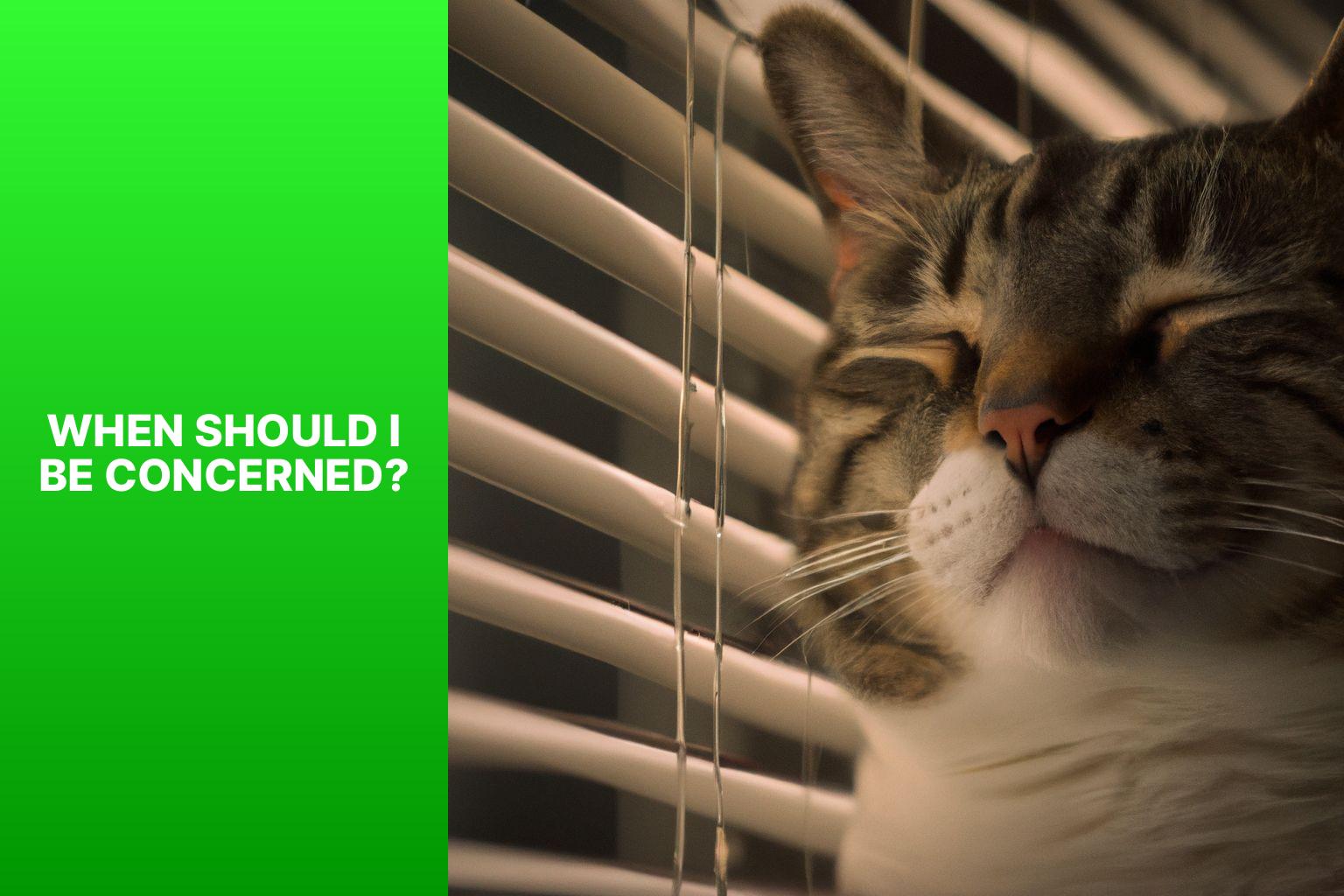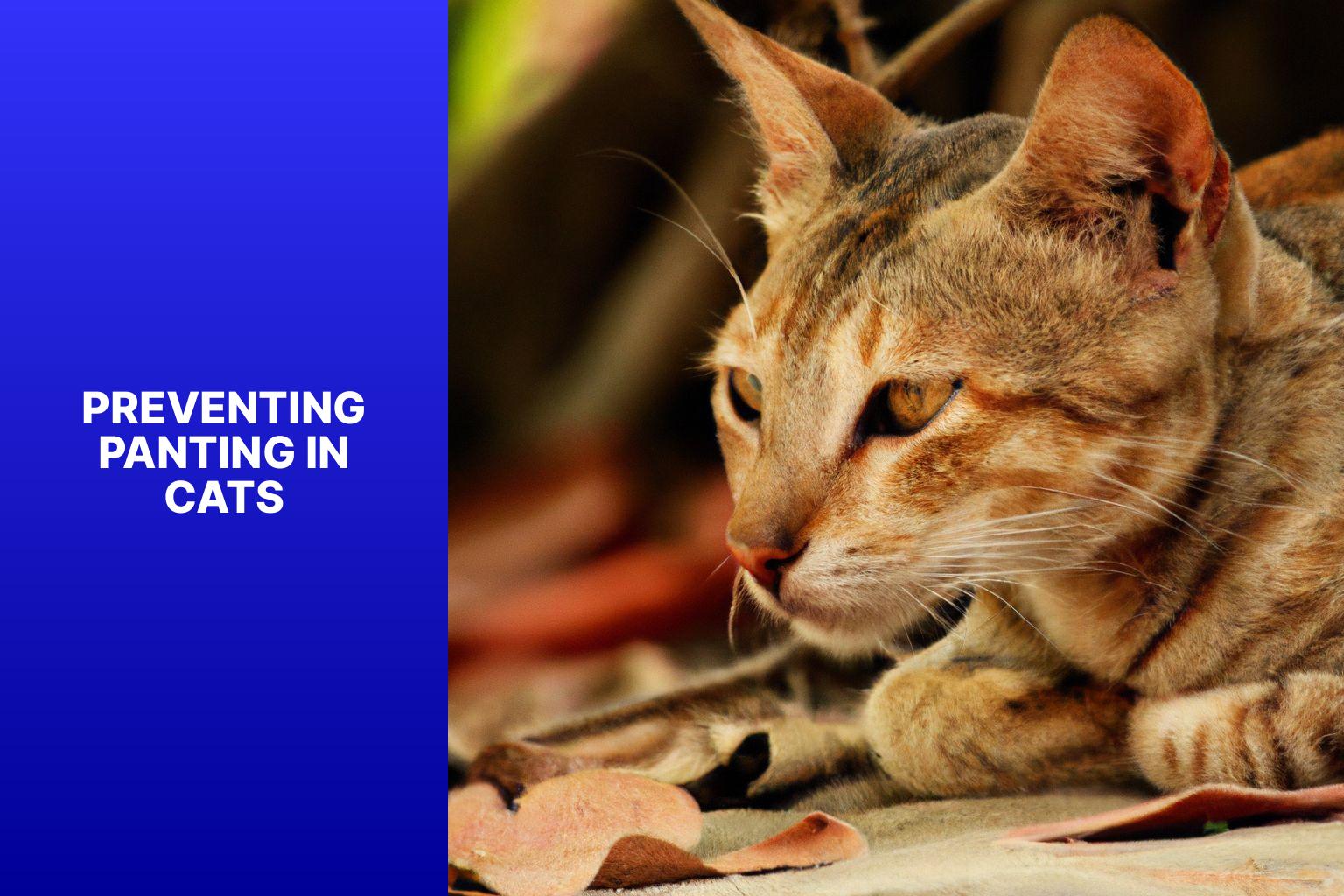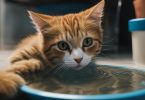Cats panting can be a cause for concern for many cat owners. Panting in cats is not as common as in dogs, and it can indicate various underlying issues. Understanding why cats pant is essential in order to identify any potential health problems and provide appropriate care. Here are some reasons why cats may pant:
-
Overheating: Cats may pant to regulate their body temperature when they are feeling too hot.
-
Stress or Anxiety: Panting can be a response to stress or anxiety in cats. It is their way of coping with a challenging situation.
-
Physical Exertion: Cats may pant after rigorous physical activity, similar to humans catching their breath after exercise.
-
Respiratory Issues: Panting can be a sign of underlying respiratory problems such as asthma or bronchitis in cats.
-
Heart Problems: Panting can be an indicator of heart issues in cats, as the heart struggles to pump blood effectively.
Knowing when to be concerned about your cat’s panting is crucial. If you notice excessive panting or if it is accompanied by other abnormal symptoms like lethargy or coughing, it is advisable to seek veterinary care.
If your cat is panting and you want to help them, here are some actions you can take:
-
Provide a cool environment: Ensure that your cat has access to a cool and well-ventilated area to help lower their body temperature.
-
Provide fresh water: Make sure your cat has access to fresh water at all times to stay hydrated.
-
Reduce stress: Create a calm and stress-free environment for your cat, as stress can contribute to panting.
-
Monitor exercise levels: Avoid excessive exertion for your cat, especially in hot or humid weather.
-
Seek veterinary care: If panting persists or you are concerned about your cat’s health, it is best to consult a veterinarian for a proper diagnosis and treatment.
Preventing panting in cats involves maintaining proper temperature regulation, scheduling regular health check-ups, and minimizing stressful situations.
Key takeaways:
Key takeaway:
- Cats may pant due to overheating, stress or anxiety, physical exertion, respiratory issues, or heart problems. Understanding the cause is important to address the issue.
- Excessive panting or the presence of other abnormal symptoms should be a cause for concern and may require seeking veterinary care.
- To help a panting cat, provide a cool environment, fresh water, reduce stress, monitor exercise levels, and consider seeking veterinary care if needed. Prevention includes proper temperature regulation, regular health check-ups, and minimizing stressful situations.
Why Do Cats Pant?
Photo Credits: Www.Catcornerblog.Com by Anthony Clark
Curiosity piqued? Let’s unravel the mysteries behind why cats pant. From overheating and stress to physical exertion and respiratory issues, we’ll uncover the reasons cats may exhibit this behavior. Brace yourself for enlightening insights into how our feline friends cool down, manage anxiety, and potentially signal underlying health concerns. Get ready to delve into the fascinating realm of why cats pant and gain a deeper understanding of their unique physiology.
Overheating
When it comes to cats, overheating is a serious concern. Factors to consider in order to prevent your cat from overheating include:
- Hot weather: Cats are more prone to overheating during hot summer months when the temperature rises.
- Lack of shade: Ensure your cat has access to a cool shaded area where they can rest and escape the sun.
- Restrict exercise: Avoid engaging your cat in strenuous physical activities during periods of hot weather.
- Indoor temperature: Maintain a comfortable temperature at home to prevent overheating. Use fans or air conditioning if necessary.
Fact: Cats are more susceptible to overheating due to their less efficient ability to cool down their bodies compared to humans.
Stress or Anxiety
Stress or anxiety can cause panting in cats. Cats may experience stress or anxiety in certain situations, such as when introduced to a new environment or when there are changes in their routine. Stress and anxiety can lead to rapid breathing and panting. Other signs of stress or anxiety in cats include restlessness, hiding, excessive vocalization, and changes in appetite.
If your cat is panting due to stress or anxiety, it’s important to address the underlying cause. Creating a calm and safe environment can help alleviate stress. Providing hiding places and vertical spaces for your cat to retreat to can also reduce anxiety. Engaging in interactive play sessions and providing mental stimulation through toys and puzzles can help alleviate stress.
In some cases, professional intervention may be necessary to manage your cat’s stress or anxiety. Consulting with a veterinarian or a feline behaviorist can provide valuable insights and guidance on how to help your cat cope.
I had a skittish cat named Whiskers. Any sudden noises or changes in the environment made him very anxious. When I moved to a new apartment, the process proved to be stressful for Whiskers. He started panting, showing signs of anxiety. To help him cope, I created a quiet and comfortable space for him in the new apartment with his favorite toys and blankets. I also used feline pheromone diffusers to create a calming atmosphere. With time, patience, and the right environment, Whiskers gradually adjusted and his panting episodes became less frequent. It taught me the importance of providing a stress-free environment for cats and being mindful of their unique sensitivities to changes.
Physical Exertion
Cats engage in physical exertion through vigorous exercise or play, causing their body temperature to rise. As a result, they may pant to cool down and regulate their body temperature by releasing excess heat. During this period, cats breathe faster and deeper, and their heart rate increases to supply oxygen to their muscles. It is essential to monitor cats during physical exertion to prevent them from overexerting themselves. To prevent dehydration, it’s recommended to offer them opportunities to rest and hydrate during and after exercise. If a cat continues to pant excessively or shows signs of distress even after rest, it may require veterinary attention. While regular exercise is crucial for a cat’s well-being, it should be done in moderation to avoid exhaustion or overheating. If you observe any abnormal symptoms or changes in behavior during or after physical exertion, it is best to consult a veterinarian for professional advice.
Respiratory Issues
Respiratory issues in cats can range from mild congestion to serious conditions like upper respiratory infections or chronic inflammation of the lungs. Signs of respiratory distress in cats include rapid breathing, struggling to breathe, and trouble getting air. If your cat is panting and showing signs of respiratory issues, seek veterinary care immediately.
Monitor your cat’s gum color, as pale or blue gums may indicate a lack of oxygen. Respiratory issues can be caused by factors such as stress, heart disease, and respiratory infections. The necessary treatment will depend on the severity of the condition.
In a true story, a cat named Milo developed respiratory issues after being exposed to cats with upper respiratory infections at a cat show. He struggled to breathe and had rapid breathing. His owner rushed him to the veterinarian, who diagnosed him with a respiratory infection. With proper treatment and antibiotics, Milo’s condition improved, and he made a full recovery.
If you notice any respiratory issues in your cat, consult a veterinarian for a professional opinion and proper diagnosis. Prompt medical attention can prevent further complications and ensure your cat’s well-being. Remember, respiratory issues in cats should never be ignored and should be treated as a potential medical emergency.
Heart Problems
Heart problems in cats, such as heart disease, can cause panting and should be taken seriously. Improper heart function in cats can lead to respiratory distress and a lack of oxygen in their body, resulting in rapid breathing and panting. If you notice excessive panting accompanied by difficulty breathing, coughing, and changes in gum color, it could indicate heart failure in cats. In such cases, immediate veterinary care is essential. It is crucial to seek a professional diagnosis to determine the appropriate treatment for your cat.
To prevent heart problems in cats, it is important to schedule regular health check-ups and monitor your cat’s well-being. Creating a calm environment with minimal stress can also help in preventing such issues. Remember, heart problems in cats are a medical emergency, and if you notice any symptoms or have concerns, it is highly recommended to address them with a veterinarian.
When Should I Be Concerned?
Photo Credits: Www.Catcornerblog.Com by Benjamin Jones
Is your cat panting more than usual? In this section, we’ll explore when you should be concerned about your cat’s excessive panting. We’ll also touch upon other abnormal symptoms that may accompany excessive panting. Stay tuned to learn more about the warning signs that could indicate a potential health issue in your feline friend.
Excessive Panting
Excessive panting in cats may indicate underlying health problems. Factors to consider include:
1. Overheating: Cats may pant when overheated. Ensure a cool environment and provide fresh water.
2. Stress or Anxiety: Excess panting can be a response to stress or anxiety. Reduce stressors and create a calm space.
3. Physical Exertion: Cats pant after vigorous activity. Monitor exercise levels and provide rest.
4. Respiratory Issues: Panting can signal respiratory distress or infections. Seek veterinary care.
5. Heart Problems: Excessive panting can indicate heart disease or failure. Monitor gum color and breathing. Consult a veterinarian.
My cat once excessively panted after a stressful vet visit. I created a calm environment at home, and the panting subsided within days.
Remember, seek immediate veterinary care if your cat has trouble breathing or excessive panting in emergencies.
Other Abnormal Symptoms
If you notice any of these other abnormal symptoms in your cat along with panting, it is essential to seek veterinary care immediately. These signs could indicate a medical emergency or serious health concerns. A professional opinion is crucial in determining the underlying cause and providing appropriate treatment. Remember, early intervention can greatly improve the outcome for your beloved feline companion.
What Can I Do to Help?
Feeling concerned about your panting cat? Wondering what you can do to help? In this section, we’ll explore effective ways to support your furry friend during this uncomfortable time. From creating a cool environment to monitoring exercise levels, we’ve got you covered. Stay tuned for some valuable tips and tricks that will ensure your cat’s well-being. Remember, your pet’s health is our priority!
Cool Environment
Creating a cool environment is crucial for helping your panting cat. Cats rely on a cool environment to regulate their body temperature effectively. Providing a cool environment can alleviate their discomfort and promote their well-being. Here are steps to create a cool environment for your cat:
1. Ensure proper ventilation in your home. Open windows or use fans to circulate fresh air.
2. Keep your cat in a well-ventilated area with access to cool surfaces, such as tiled floors or countertops.
3. Avoid exposing your cat to direct sunlight or hot areas. Provide shade or use curtains to block out sunlight.
4. Use cool water to dampen a towel or cloth and gently rub it over your cat’s fur. This can help cool them down.
5. Consider using a cooling mat or pad designed for pets. These mats can provide a cool surface for your cat to lie on.
Creating a cool environment for your cat helps prevent overheating and reduces the need for panting. Remember to monitor your cat’s behavior and contact a veterinary professional if you have any health concerns.
Provide Fresh Water
To provide fresh water for your cat, follow these steps:
- Regularly refill your cat’s water bowl with clean water. Cats prefer running water, so consider getting a cat water fountain to encourage them to drink more.
- Use filtered water to remove impurities or contaminants in tap water. This ensures that your cat drinks clean and safe water.
- Keep the water bowl in a cool and easily accessible location. Cats prefer water that is within reach and away from their litter box or food.
- Add ice cubes to your cat’s water bowl during hot weather to keep the water cool. This helps prevent dehydration and overheating.
- If you have multiple cats or a large house, provide multiple water sources to accommodate their needs. This prevents competition and ensures access to fresh water.
Remember, providing fresh water is crucial for your cat’s health. It prevents dehydration, maintains organ function, and aids digestion. If you notice changes in their water intake or if they’re not drinking enough, consult a veterinarian for potential health concerns.
Reduce Stress
Stress can have a negative impact on a cat’s well-being, so it is of utmost importance to actively work towards reducing stress in their environment. One way to do this is by providing a designated safe and calm space in your home where your cat can retreat to whenever they feel overwhelmed. It is crucial to establish a routine that helps to alleviate anxiety and create a sense of security for your furry friend.
Interacting and engaging in playtime with your cat is essential for reducing stress. Regular play sessions using appropriate toys not only help to alleviate stress but also provide mental stimulation for your pet. It is beneficial to provide scratching posts and vertical spaces for climbing as these activities help to release energy and further reduce stress.
Creating a peaceful environment for your cat is vital in reducing stress levels. Avoid sudden changes or disruptions to your cat’s routine, as they can be overwhelming and cause additional stress. Providing hiding spots and vertical perches in your home can give your cat a sense of security, which aids in reducing stress.
If your cat’s stress levels persist despite your efforts, it is recommended to seek advice from a veterinarian. They can provide guidance on behavior modification techniques, suggest dietary changes, or even prescribe medications if necessary to help alleviate your cat’s stress.
Remember, reducing stress in cats is vital for their overall well-being. By proactively working towards reducing stress, you can help your furry friend lead a happier and healthier life.
Fact: Reducing stress in cats also has a positive impact on their physical health. Chronic stress in cats can increase the risk of respiratory illnesses and heart disease.
Monitor Exercise Levels
Monitor Exercise Levels
To monitor exercise levels in your cat, pay attention to their activity level. Cats that engage in excessive physical activity may be more prone to panting. Watch for signs of fatigue, such as heavy panting or struggling to catch their breath. If your cat consistently pants during exercise, seek veterinary care to rule out any underlying health concerns. Regularly check your cat’s gum color and seek professional help if their gums appear pale or bluish. Ensure your cat exercises in a cool and well-ventilated environment to prevent overheating. By maintaining a healthy exercise routine and addressing potential health issues, you can help prevent excessive panting and ensure your cat’s well-being.
Seek Veterinary Care
If your panting cat exhibits abnormal symptoms or behaviors, seek veterinary care. A veterinarian can diagnose any underlying medical conditions that may be causing the panting. They can assess respiratory distress, check for heart disease or other health concerns, and provide treatment.
If your cat struggles to breathe, has rapid breathing, or shows signs of respiratory distress, it could be a medical emergency. Seek veterinary care immediately. Other signs to watch for include a change in gum color, difficulty breathing, or persistent excessive panting.
Cats can develop respiratory illnesses like cat asthma or chronic inflammation of the lungs, leading to panting. Seeking veterinary care can identify and manage these conditions, ensuring necessary treatment and preventing complications.
Preventing Panting in Cats
Photo Credits: Www.Catcornerblog.Com by Matthew King
Worried about your furry friend’s unusual panting? In this section, we’ll explore ways to prevent panting in cats, from ensuring proper temperature regulation to scheduling regular health check-ups. We’ll also discuss techniques to minimize stressful situations that may trigger panting in our feline companions. So, let’s dive in and learn how to keep our cats cool, calm, and panting-free!
Proper Temperature Regulation
Maintaining cats’ health and well-being requires proper temperature regulation. Cats are sensitive to temperature changes and can easily become too hot or too cold. Providing a comfortable environment helps them maintain a normal body temperature.
To ensure proper temperature regulation for your cat:
1. Keep your home at a moderate temperature, between 68-78 degrees Fahrenheit (20-25 degrees Celsius). This range provides a comfortable environment without causing discomfort.
2. Give your cat access to warm and cool areas in your home so they can choose their preferred temperature.
3. During hot weather, make sure your cat has access to cool spots like tiled floors or shaded areas. Fans or air conditioning can also help cool down the room.
4. In cold weather, provide warm spots like blankets, beds, or heated mats for your cat to snuggle on. Avoid placing them near drafts or cold areas.
5. Regularly monitor the temperature in your cat’s environment to ensure it stays within the optimal range.
Pro-tip: Adjust the temperature and comfort levels for your cat according to seasonal changes.
Note: This article is not yet complete and does not contain ending statements.
Regular Health Check-ups
Regular health check-ups are crucial for your cat’s well-being. Here’s why:
- Early detection of medical conditions: Regular health check-ups ensure the early detection of underlying medical conditions. Cats hide signs of illness, so symptoms might show up after the condition has worsened.
- Prevention of health concerns: Through regular health check-ups, vaccinations, deworming, and parasite prevention can be administered to protect against common illnesses.
- Monitoring overall health: Regular health check-ups allow for the monitoring of weight, dental health, organ function, and physical condition. Prompt action can be taken for any changes or abnormalities found.
- Professional opinion and advice: Regular health check-ups provide the opportunity for discussions about concerns. Veterinarians can provide advice on nutrition, exercise, and behavior.
- Early detection of potential emergencies: Regular health check-ups can identify potential emergencies. By monitoring your cat’s health on a consistent basis, signs of heart failure or respiratory distress can be detected early.
Remember, regular health check-ups maintain your cat’s health and prevent serious conditions.
Minimize Stressful Situations
To minimize stress for your cat, it is important to create a calm environment. Providing a designated space where your cat can retreat when anxious can also help. Establishing a consistent daily routine can reduce uncertainty and promote security. Using pheromone diffusers or calming sprays can create a soothing atmosphere.
It is best to avoid sudden changes in your cat’s environment or routine. Giving your cat opportunities for mental and physical stimulation through play and exercise is crucial. Ensuring your cat has a cozy resting area where they can relax undisturbed is important as well.
Minimizing exposure to loud noises or sudden sounds that can stress your cat is necessary. Handle your cat gently and provide positive reinforcement for good behavior. If needed, seek guidance from a veterinarian or animal behaviorist for managing and minimizing stress for your cat.
Some Facts About Why Is My Cat Panting:
- ✅ Cats pant to release heat from their bodies because they cannot sweat enough.
- ✅ Panting can also be a sign of stress in cats, especially during car rides.
- ✅ If a cat is panting in a car, it is important to get them out of the car as soon as possible and seek veterinary attention if they are drooling excessively or seem weak.
- ✅ Planning ahead and keeping the cat cool can help reduce their stress during car rides.
- ✅ Panting in cats can also be a sign of underlying heart issues, especially in senior cats.








